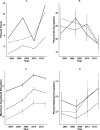Determinants of Short-term Movement in a Developing Region and Implications for Disease Transmission
- PMID: 28901976
- PMCID: PMC5718955
- DOI: 10.1097/EDE.0000000000000751
Determinants of Short-term Movement in a Developing Region and Implications for Disease Transmission
Abstract
Background: Human mobility is important for infectious disease spread. However, little is known about how travel varies by demographic groups and how this heterogeneity influences infectious disease risk.
Methods: We analyzed 10 years of survey data from 15 communities in a remote but rapidly changing region in rural Ecuador where road development in the past 15-20 years has dramatically changed travel. We identify determinants of travel and incorporate them into an infection transmission model.
Results: Individuals living in communities more remote at baseline had lower travel rates compared with less remote villages (adjusted odds ratio [OR] = 0.51; 95% confidence interval [CI] = 0.38, 0.67). Our model predicts that less remote villages are, therefore, at increased disease risk. Though road building and travel increased for all communities, this risk differential remained over 10 years of observation. Our transmission model also suggests that travelers and nontravelers have different roles in disease transmission. Adults travel more than children (adjusted OR = 1.73; 95% CI = 1.30, 2.31) and therefore disseminate infection from population centers to rural communities. Children are more likely than adults to be infected locally (attributable fraction = 0.24 and 0.09, respectively) and were indirectly affected by adult travel patterns.
Conclusions: These results reinforce the importance of large population centers for regional transmission and show that children and adults may play different roles in disease spread. Changing transportation infrastructure and subsequent economic and social transitions are occurring worldwide, potentially causing increased regional risk of disease.
Conflict of interest statement
Figures



Similar articles
-
Increased infection severity in downstream cities in infectious disease transmission and tourists surveillance analysis.J Theor Biol. 2019 Jun 7;470:20-29. doi: 10.1016/j.jtbi.2019.03.004. Epub 2019 Mar 6. J Theor Biol. 2019. PMID: 30851275 Free PMC article.
-
Travel patterns in China.PLoS One. 2011 Feb 2;6(2):e16364. doi: 10.1371/journal.pone.0016364. PLoS One. 2011. PMID: 21311745 Free PMC article.
-
Multinational patterns of seasonal asymmetry in human movement influence infectious disease dynamics.Nat Commun. 2017 Dec 12;8(1):2069. doi: 10.1038/s41467-017-02064-4. Nat Commun. 2017. PMID: 29234011 Free PMC article.
-
[Impact of changes in the environment on vector-transmitted diseases].Sante. 1997 Jul-Aug;7(4):263-9. Sante. 1997. PMID: 9410453 Review. French.
-
Infectious Risks of Air Travel.Microbiol Spectr. 2015 Oct;3(5). doi: 10.1128/microbiolspec.IOL5-0009-2015. Microbiol Spectr. 2015. PMID: 26542037 Review.
Cited by
-
Characterizing dengue transmission in rural areas: A systematic review.PLoS Negl Trop Dis. 2023 Jun 8;17(6):e0011333. doi: 10.1371/journal.pntd.0011333. eCollection 2023 Jun. PLoS Negl Trop Dis. 2023. PMID: 37289678 Free PMC article.
-
Pandemic-associated food insecurity in northern, coastal Ecuador.J Hunger Environ Nutr. 2024;19(6):1261-1276. doi: 10.1080/19320248.2023.2301074. Epub 2024 Jan 5. J Hunger Environ Nutr. 2024. PMID: 39872678 Free PMC article.
-
Trends of child undernutrition in rural Ecuadorian communities with differential access to roads, 2004-2013.Matern Child Nutr. 2018 Jul;14(3):e12588. doi: 10.1111/mcn.12588. Epub 2018 Feb 7. Matern Child Nutr. 2018. PMID: 29411943 Free PMC article.
-
Effect of childhood rotavirus vaccination on community rotavirus prevalence in rural Ecuador, 2008-13.Int J Epidemiol. 2020 Oct 1;49(5):1691-1701. doi: 10.1093/ije/dyaa124. Int J Epidemiol. 2020. PMID: 32844206 Free PMC article.
-
Locals get travellers' diarrhoea too: risk factors for diarrhoeal illness and pathogenic Escherichia coli infection across an urban-rural gradient in Ecuador.Trop Med Int Health. 2019 Feb;24(2):205-219. doi: 10.1111/tmi.13183. Epub 2018 Dec 6. Trop Med Int Health. 2019. PMID: 30444557 Free PMC article.
References
MeSH terms
Grants and funding
LinkOut - more resources
Full Text Sources
Other Literature Sources
Medical
Miscellaneous

